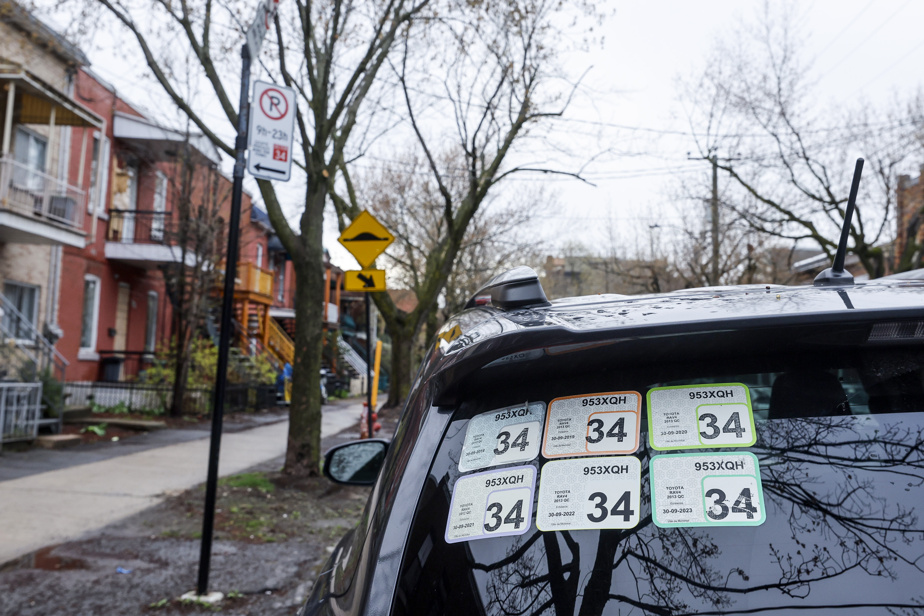A price according to the mass

PHOTO HUGO-SÉBASTIEN AUBERT, LA PRESSE ARCHIVES
Owners of electric or plug-in hybrid vehicles will not escape the new tariffs, but in their case, the categories will be a little different.
Under the new system, which will come into effect on 1er July, Rosemont–La Petite-Patrie will now charge $115 for a gas-powered – or non-plug-in hybrid – vehicle weighing 1249 kg or less. The bill will rise to $205 for those whose mass exceeds 1600 kg. Owners of electric or plug-in hybrid vehicles will not escape this, but in their case, the categories will be a little different. Thus, the bill will be $115 if their vehicle weighs less than 1550 kg and will go up to $205 for a vehicle weighing 1850 kg or more. It will cost $385 to obtain a sticker for a second vehicle, regardless of its weight.

“Slight increase” in prices
The borough recognizes that its pricing system will lead to a “slight increase” in the bill for the average motorist. The best-selling vehicle in Canada in all categories, the Ford F-150 will inherit the highest bill. Its average weight of 2274 kg places it at the very top of the pricing scale. The majority of sport utility vehicles (SUVs) will also be at the top of the scale. Weighing from 1525 kg to 1950 kg depending on the equipment, a Toyota RAV4 will result in a bill of $175 to $205. To pay the lower rate, you will have to drive a vehicle such as the Toyota Yaris, which weighs between 980 kg and 1120 kg. Note: “provisions” will nevertheless be provided “to limit the costs for people with reduced mobility and low income”.

PHOTO MARCO CAMPANOZZI, PRESS ARCHIVES
François Limoges, mayor of the borough of Rosemont–La Petite-Patrie
Decrease the pressure
For the time being, Montreal boroughs set the price of their parking permits based on the size of the engine capacity of the vehicles. General rule: the more fuel your vehicle consumes, the more the vignette costs. Rosemont–La Petite-Patrie, however, says today that “the best data” to show the public space occupied by a vehicle when it is parked is its net mass. “The engines have evolved, there is no longer an exact correlation between the engine capacity and the size of the vehicles. We can see this in particular in the fact that there are more and more large vehicles with small engines,” said the mayor of the borough, François Limoges, in an interview with The Press. “What we would like to price ideally is the size. But we don’t have it. We have the weight, that said, in the registers of the SAAQ, ”he continues.

PHOTO MARTIN CHAMBERLAND, THE PRESS
Parking sign in Rosemont–La Petite-Patrie
Less space
According to Mr. Limoges, it is costing the boroughs more and more to manage parking. Citizens often denounce the disappearance of parking spaces, but the increase in the size of vehicles reduces the number of spaces available. “Cars are taking up more and more space. In our sector, the increase in the size of cars has led to the reduction of 4,000 to 10,000 parking spaces, therefore approximately 10 to 25% of spaces. And that is for a single borough: I let you imagine on the scale of Quebec, ”breathes the elected municipal official. For him, the reality is very simple: “manufacturers systematically put more massive vehicles on the market, except that they forget that all this has a growing cost for infrastructure”. “A RAM 150 takes the place of two Yaris on the street. We must take this into account, ”insists the mayor.

PHOTO MARTIN CHAMBERLAND, THE PRESS
Parking permits in Rosemont–La Petite-Patrie
Towards a broader discussion?
François Limoges does not hide the fact that he hopes to “snowball” with his new pricing regulations. “We also hope to start a conversation more generally about vehicle size, so that other people can look into the question and also study the impact on safety. This discussion needs to take place,” he said. His administration also hopes to “encourage those who have no choice but to use a vehicle in their travels to opt for smaller formats, or better, for car sharing”. Ultimately, adds the elected official, the objective is “the adoption of active modes of transport and the reduction of dependence on the automobile”.

PHOTO PATRICK SANFAÇON, LA PRESSE ARCHIVES
Valérie Plante, Mayor of Montreal
No “wall-to-wall”, promises Plante
“Studies show that the larger the vehicle, the greater the risk of collisions due to unlimited visibility. […] I therefore really invite the mayors of the other boroughs to take a close interest in this question, ”said the mayoress of Montreal, Valérie Plante, on Tuesday, who however promises not to do “wall-to-wall”. with such measures. Its borough, Ville-Marie, has also adopted pricing measures related to eco-taxation in recent years. The director of government relations at Équiterre, Marc-André Viau, believes that “this modernization of the regulations is major and will inevitably have a ripple effect on the regulations for on-street parking almost everywhere in Quebec, because all the municipalities are grappling with the same problems.
Learn more
-
- 154,000
- Increase in the number of passenger vehicles on the island of Montreal between 2001 and 2021, a jump of almost 22% in 20 years
Source: Quebec Automobile Insurance Company
- 189%
- Since 2001, the proportion of light truck type vehicles has jumped 189.7%. In 2021, they constituted 41.4% of the Montreal automobile fleet, a proportion 2.3 times higher than 20 years ago.
Source: Quebec Automobile Insurance Company
